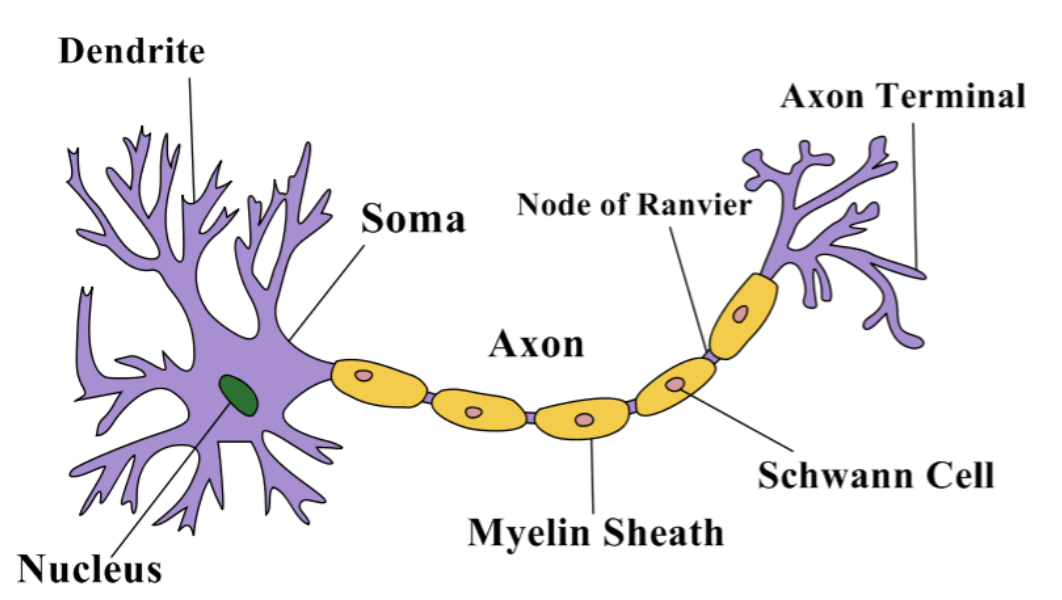
Draw a labelled diagram of the neuron and describe the structure of the neuron in detail.
Answer
574.5k+ views
Hint: The cell forms the basic unit of life. Every part of the body has a specialized cell which will perform only a particular activity. They work in the specified area. They are composed of various units which will enhance their efficiency.
Complete answer:
Brain is the most important organ of the body as it coordinates the whole body to work together. The cells of the brain are called the nerve cells/neuron.
They form the structural unit as well as the functional unit of the nervous system. They have major 3 components- Cell body, Axon and dendrites.

1. Cell body: It forms the cytoplasm of the nerve cell. It is polyhedral in shape. It also has the granular bodies known as Nissl's granules. Their major function is to synthesize protein via the ribosomes.
2. Dendrites: This is the branched fibril part of the neuron. They transmit the electrical impulse towards the cyton or cell body. They protrude out of the cell body.
3. Axon: These form the distal part of the neuron. They are the long fibres protruding from the cell body. It ends in the synaptic knob. Neurotransmitters are filled in this area of neurons. Axon has Axoplasm, myelin sheath, neurilemma and nodes of Ranvier.
Hence, the correct answer is option (B).
Note: The average brain has millions of neurons. The diameter of the neuron can be up to 100 microns. They are the electrically excited cells of the body. They form the component of the brain, spinal cord and peripheral nerves. They all make the nervous system.
Complete answer:
Brain is the most important organ of the body as it coordinates the whole body to work together. The cells of the brain are called the nerve cells/neuron.
They form the structural unit as well as the functional unit of the nervous system. They have major 3 components- Cell body, Axon and dendrites.

1. Cell body: It forms the cytoplasm of the nerve cell. It is polyhedral in shape. It also has the granular bodies known as Nissl's granules. Their major function is to synthesize protein via the ribosomes.
2. Dendrites: This is the branched fibril part of the neuron. They transmit the electrical impulse towards the cyton or cell body. They protrude out of the cell body.
3. Axon: These form the distal part of the neuron. They are the long fibres protruding from the cell body. It ends in the synaptic knob. Neurotransmitters are filled in this area of neurons. Axon has Axoplasm, myelin sheath, neurilemma and nodes of Ranvier.
Hence, the correct answer is option (B).
Note: The average brain has millions of neurons. The diameter of the neuron can be up to 100 microns. They are the electrically excited cells of the body. They form the component of the brain, spinal cord and peripheral nerves. They all make the nervous system.
Recently Updated Pages
Why are manures considered better than fertilizers class 11 biology CBSE

Find the coordinates of the midpoint of the line segment class 11 maths CBSE

Distinguish between static friction limiting friction class 11 physics CBSE

The Chairman of the constituent Assembly was A Jawaharlal class 11 social science CBSE

The first National Commission on Labour NCL submitted class 11 social science CBSE

Number of all subshell of n + l 7 is A 4 B 5 C 6 D class 11 chemistry CBSE

Trending doubts
Differentiate between an exothermic and an endothermic class 11 chemistry CBSE

10 examples of friction in our daily life

One Metric ton is equal to kg A 10000 B 1000 C 100 class 11 physics CBSE

Difference Between Prokaryotic Cells and Eukaryotic Cells

1 Quintal is equal to a 110 kg b 10 kg c 100kg d 1000 class 11 physics CBSE

State the laws of reflection of light




